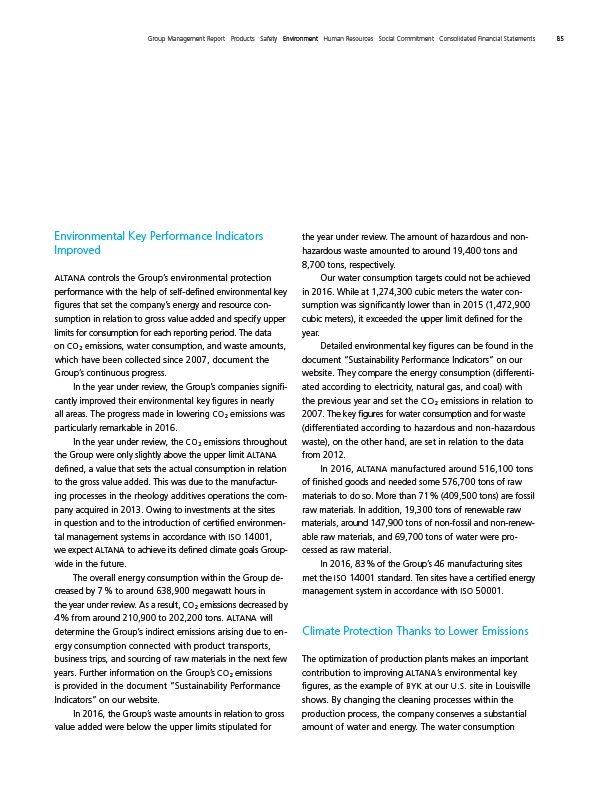
Group Management Report Products Safety Environment Human Resources Social Commitment Consolidated Financial Statements 85
Environmental Key Performance Indicators
Improved
ALTANA controls the Group’s environmental protection
performance
with the help of self-defined environmental key
figures that set the company’s energy and resource consumption
in relation to gross value added and specify upper
limits for consumption for each reporting period. The data
on CO² emissions, water consumption, and waste amounts,
which have been collected since 2007, document the
Group’s continuous progress.
In the year under review, the Group’s companies significantly
improved their environmental key figures in nearly
all areas. The progress made in lowering CO² emissions was
particularly remarkable
in 2016.
In the year under review, the CO² emissions throughout
the Group were only slightly above the upper limit ALTANA
defined, a value that sets the actual consumption in relation
to the gross value added. This was due to the manufacturing
processes in the rheology additives operations the company
acquired in 2013. Owing to investments at the sites
in question and to the introduction of certified environmental
management systems in accordance with ISO 14001,
we expect ALTANA to achieve its defined climate goals Group‑wide
in the future.
The overall energy consumption within the Group decreased
by 7 % to around 638,900 megawatt hours in
the year under review. As a result, CO² emissions decreased by
4 % from around 210,900 to 202,200 tons. ALTANA will
determine the Group’s indirect emissions arising due to en-
ergy consumption connected with product transports,
business trips, and sourcing of raw materials in the next few
years. Further information on the Group’s CO² emissions
is provided in the document “Sustainability Performance
Indicators” on our website.
In 2016, the Group’s waste amounts in relation to gross
value added were below the upper limits stipulated for
the year under review. The amount of hazardous and non-
hazardous waste amounted to around 19,400 tons and
8,700 tons, respectively.
Our water consumption targets could not be achieved
in 2016. While at 1,274,300 cubic meters the water consumption
was significantly lower than in 2015 (1,472,900
cubic meters), it exceeded the upper limit defined for the
year.
Detailed environmental key figures can be found in the
document “Sustainability Performance Indicators” on our
website. They compare the energy consumption (differenti
ated according to electricity, natural gas, and coal) with
the previous year and set the CO² emissions in relation to
2007. The key figures for water consumption and for waste
(differentiated according to hazardous and non-hazardous
waste), on the other hand, are set in relation to the data
from 2012.
In 2016, ALTANA manufactured around 516,100 tons
of finished goods and needed some 576,700 tons of raw
materials to do so. More than 71 % (409,500 tons) are fossil
raw materials. In addition, 19,300 tons of renewable raw
materials, around 147,900 tons of non-fossil and non-renewable
raw materials, and 69,700 tons of water were processed
as raw material.
In 2016, 83 % of the Group’s 46 manufacturing sites
met the ISO 14001 standard. Ten sites have a certified energy
management system in accordance with ISO 50001.
Climate Protection Thanks to Lower Emissions
The optimization of production plants makes an important
contribution to improving ALTANA’s environmental key
figures,
as the example of BYK at our U.S. site in Louisville
shows. By changing the cleaning processes within the
production
process, the company conserves a substantial
amount of water and energy. The water consumption